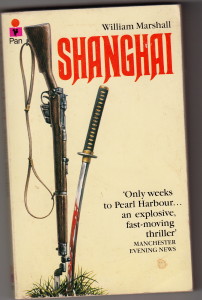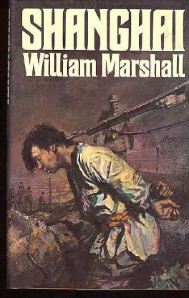Posted: March 28th, 2014 | No Comments »
Just for a change today, a few shots of old Bombay…
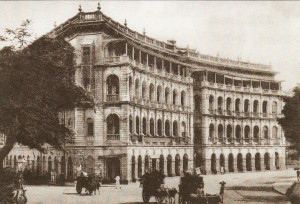
Elphinstone Circle remains a marvellous site of old Bombay, and in pretty good nick considering (it helps that some of the shops at ground level have been refurbished with brands like Hermes moving in). The park in the middle of the circle is also still in fairly good working order. The Circle dates back to the 1840s and the park was long a favourite meeting spot for the city’s Parsi community.
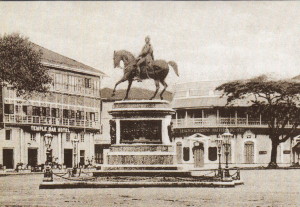
Kala Ghoda (which means black horse) was named after the black stone statue of King Edward VII. The statue was a gift from the Sassoon’s around 1870. It’s now housed at the V&A Museum (later renamed the Bhau Daji Lad Museum) in Byculla.
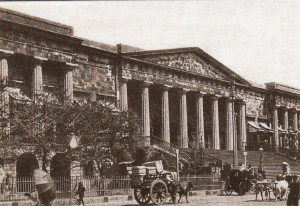
The Bombay Town Hall was built around 1830 and still stands and looks magnificent as an example of Greco-Roman influenced architecture in Bombay and rivals the British Museum building in London for grandeur. It was formerly the home of the Royal Asiatic Society of Bombay and remains in use as a library with 800,000 antique volumes (including, I believe, one of only two original copies of Dante’s Inferno)
Posted: March 27th, 2014 | No Comments »
Richard Adam Timmerscheidt had lived for a time in Shanghai and Hong Kong claiming he was an American and during the First World War vocally opposed the Kaiser in China to anyone who would listen. In actual fact he was a German who had fraudulently obtained American citizenship just four months before the war broke out which allowed him to continue to operate within the American and allied world of Shanghai. He had earlier resigned from his job with the China offices of the German brokerage firm Ladenburg, Thalmann and Company to work briefly for a finance firm in Berlin before returning to the Far East and taking up the influential post of Manager of the Hong Kong branch of the German Asiatic Bank which was closely connected to the Qing Imperial Government in Peking. It was during this period he got to know many prominent Shanghailanders from all sides of the tracks.
Â
After the war broke out Timmerscheidt moved to New York to run the Manhattan operations of the German Asiatic Bank. While in America he contacted many of his old Hong Kong and Shanghai acquaintances persuading them to invest money with him and promising big returns. Many did; including several quite wealthy American women. Most invested just shy of US$20,000 (roughly US$420,000 in today’s money) with Timmerscheidt displaying just how wealthy some Shanghailanders were at the time.
In 1917 America joined the war on the side of the Allies against Germany and Timmerscheidt came under suspicion for both financial fraud and for having lied to get American citizenship. Realising the game was up Timmerscheidt returned to his luxurious apartment on West 59th Street in Manhattan, slashed his wrists and then impatient at how long it was taking him to die threw himself out of the apartment window in July 1917.
Â
The story became curiouser when it appeared that Timmerscheidt had been in contact with Berlin and was using his inside knowledge of German strategies in the war to try and profit from the stock market in advance of big falls or rallies. For a time the strategy worked but then America’s entry into the war led to a drastic fall in the stock market and Timmerscheidt was largely wiped out. Those back in Shanghai who’d been ripped off argued in the American courts for years to try and reclaim their stakes. Some did eventually get some of their money back as Timmerscheidt had invested heavily in buying copper to hoard and sell to Germany. After the war there was a shortage forcing copper prices high. A few did receive a payment eventually in the 1920s, but it had seriously dented their nest egg with endless legal wrangling, high lawyers fees and the necessity of leaving Shanghai and their businesses to be based in New York for months to attend court in Manhattan.
Posted: March 26th, 2014 | No Comments »
Andrew Field of Mu Shiying: China’s Lost Modernist will be at the Hong Kong FCC on March 30th in conversation with Leo Ou-fan Lee (author of the excellent Shanghai Modern)
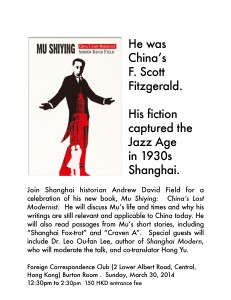
Posted: March 26th, 2014 | No Comments »
On March 26 1904 Secretary John Hay held talks with Japan’s Baron Kentaro Kaneko in the State Department in DC. The Russo-Japanese War was underway and TR liked the American-educated Kaneko. Kaneko believed that TR was siding (secretly) with Japan against Russia though Hay had to remind TR that America was technically neutral in the conflict. Kaneko later went to the White House for a reception where TR made a byline to pump his hand and proceeded to talk in decidedly neutral terms about Japan’s role as a “civilising” nation in Asia. Kaneko suggested TR read Inazo Nitobe’s Bushido to better understand Japan. According to the Japanese ambassador to DC at the time, Kogoro Takahira, summarised the conversation saying that TR expressed confidence that Japan would win the war and become Asia’s leading nation.
Arguably this is the point at which America decided to back Japan against Russia and also detach itself from Korea leading to Korea’s later colonisation by Tokyo as well as encouraging Japan’s aggression towards China. An important meeting largely forgotten now.
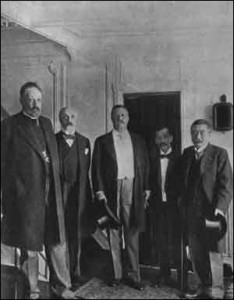 TR stands between the leaders of the Russian (left) and Japanese delegations at the 1905 Portsmouth Naval Conference (the Treaty of Portsmouth). Kenaro is to TR’s right.Â
TR stands between the leaders of the Russian (left) and Japanese delegations at the 1905 Portsmouth Naval Conference (the Treaty of Portsmouth). Kenaro is to TR’s right.Â
Posted: March 25th, 2014 | No Comments »
A picture of a Chinese general store in Hawaii around 1900. Don’t know where it was exactly but, at this time, there were around 26,000 Chinese in the islands mostly working as plantation labourers. However, some obviously moved into commerce…
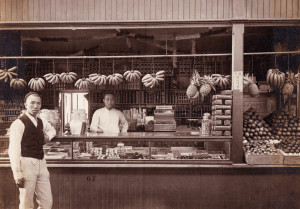
Posted: March 23rd, 2014 | 1 Comment »
Should you have felt a little home sick for Shanghai in 1930s San Francisco, there was always the Shanghai Cafe…..
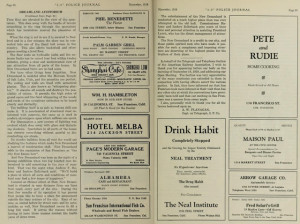
Posted: March 21st, 2014 | No Comments »
A charming book of illustrations (though not all the illustrations are charming scenes – if you see what I mean) of James McMullan’s childhood in China. McMullan, born in 1934 in China was left there after his father went to fight in World War II with the Allies. He and his mother moved around a lot – a journey that took them to Shanghai, to Calcutta, to San Francisco and many other cities in-between. McMullan’s book, Leaving China, is a set of short stories, and paintings, that depict moments in that childhood.
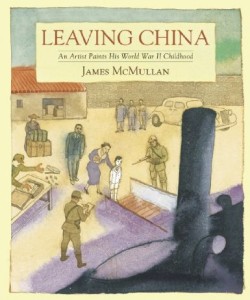 It is this dream-like quality of my memories that I wanted to capture in some way in the paintings that accompany the text—to suggest in the images that the events occurred a long time ago in a simpler yet more exotic world, and that the players in that world, including me, are at a distance.â€
It is this dream-like quality of my memories that I wanted to capture in some way in the paintings that accompany the text—to suggest in the images that the events occurred a long time ago in a simpler yet more exotic world, and that the players in that world, including me, are at a distance.â€
Artist James McMullan’s work has appeared in the pages of virtually every American magazine, on the posters for more than seventy Lincoln Center theater productions, and in bestselling picture books. Now, in a unique memoir comprising more than fifty short essays and illustrations, the artist explores how his early childhood in China and wartime journeys with his mother influenced his whole life, especially his painting and illustration.
James McMullan was born in Tsingtao, North China, in 1934, the grandson of missionaries who settled there. As a little boy, Jim took for granted a privileged life of household servants, rickshaw rides, and picnics on the shore—until World War II erupted and life changed drastically. Jim’s father, a British citizen fluent in several Chinese dialects, joined the Allied forces. For the next several years, Jim and his mother moved from one place to another—Shanghai, San Francisco, Vancouver, Darjeeling—first escaping Japanese occupation then trying to find security, with no clear destination except the unpredictable end of the war. For Jim, those ever-changing years took on the quality of a dream, sometimes a nightmare, a feeling that persists in the stunning full-page, full-color paintings that along with their accompanying text tell the story of Leaving China.
Posted: March 20th, 2014 | No Comments »
Somehow I had never heard of William Marshall’s 1979 novel Shanghai, climaxing in November 1941 (and starting in 1923) and featuring a cast of characters including an SMP cop, a disbarred American lawyer, an old China Hand and many others. It’s actually a pretty rollicking read and a bit of a page turner….
Marshall was an Australian best known for an interesting sounding series of Hong Kong set thrillers called the “Yellowthread Street” – apparently the BBC made a series of the books but I’m afraid I don’t know either the novels or the TV show. Shanghai is a bit of a mystery as it isn’t listed on Marshall’s Wikipedia page (unless it was published under another name in America – the copies below are UK editions).
And, if for nothing else, Shanghai is worth a read as it contains the immortal, and completely true then and now, statement:
“…the one great drawback to a city like Shanghai, with its many advantages, has been that its lack of basic discipline seems to have always attracted men and women of quite the wrong type.”
